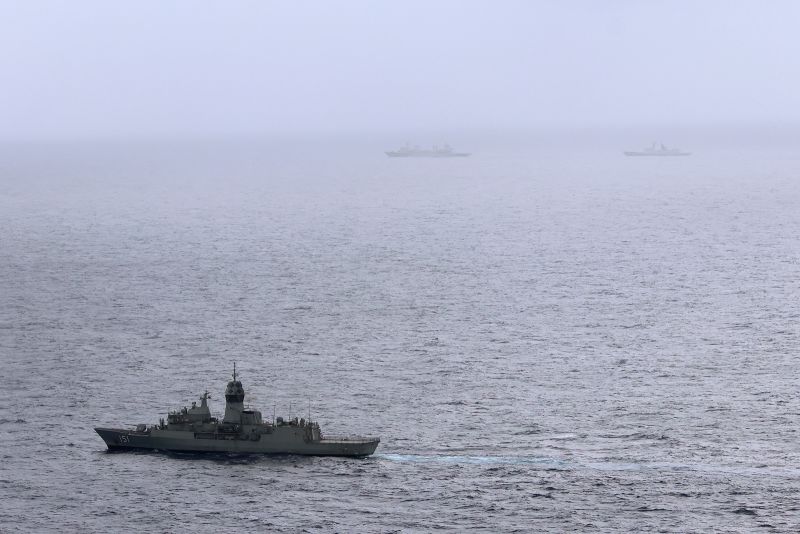Australia learned about Chinese live-fire naval drills off the country’s coast that forced dozens of flights to be diverted via an alert from a commercial pilot, authorities said on Monday.
The People’s Liberation Army (PLA) Navy’s unprecedented show of firepower in waters between Australia and New Zealand has raised alarm in both countries in recent days as a clearer picture emerges of how much warning Beijing gave about the exercises.
The first notice of the Chinese drills in the Tasman Sea came in a radio transmission on an emergency frequency monitored by a Virgin Australia passenger jet on Friday, according to Australian officials.
The Virgin pilot relayed the information to Australian aviation authorities, who then issued a “hazard alert” via air traffic control, Airservices Australia CEO Rob Sharp told a parliamentary hearing.
Airservices Australia Deputy CEO Peter Curran told the hearing that at least 49 aircraft diverted their flight paths on Friday to avoid the flotilla of three Chinese warships conducting the exercise.
The New Zealand and Australian governments said China did not issue a Notice to Airmen (NOTAM) about the drills, which they said took place in two rounds in the Tasman Sea on Friday and Saturday.
A NOTAM tells aviators about airspace changes and can be issued up to seven days before events like the live-fire drills, according to US authorities.
China’s Ministry of Defense said Sunday that the exercises conducted in international waters complied with international law and did not affect aviation safety. It also slammed Australia for “hyping up” the drills and making “unreasonable accusations.”
Though the drills were held in international waters, Beijing could have given Australia and New Zealand a heads-up much sooner in the interests of safety, naval experts said.
Defense analyst Jennifer Parker, a former Australian naval officer, wrote in a blog post Sunday that the Chinese ships did not violate international law and were well within their rights to conduct the live fire drills where they did, in the open ocean.
“It’s not aggressive, it’s just what warships do on the high seas,” Parker wrote. “There is no legal obligation for foreign warships to notify coastal nations over 300 nautical miles away about live firing activities on the high seas.”
But Parker said the Chinese ships may not have followed best practices, under which live-fire drills should maintain a safe distance from commercial flight routes.
“Indications from flight diversions suggest that the Chinese warships may have been too close to civilian air transit routes. If this is the case, it represents poor practice that warrants diplomatic discussion,” she wrote.
Analyst Carl Schuster, a former US Navy captain, was blunter.
“Forcing aircraft to divert from their internationally recognized routes is considered unsafe and irresponsible,” Schuster said.
Australia’s Prime Minister Anthony Albanese said on Saturday that while China’s drills complied with international law, Beijing “could have given more notice.”
Judith Collins, the defense minister of New Zealand, said China’s warning should have come hours earlier.
“There was a warning to civil aviation flights, that was basically a very short amount of notice, a couple of hours, as opposed to what we would consider best practice, which is 12-24 hours’ notice, so that aircraft are not having to be diverted when they’re on the wing,” she told public broadcaster Radio New Zealand (RNZ).
‘Standard procedure’
By Tuesday, the Chinese ships had moved to about 160 miles east of Hobart on the southern island of Tasmania, and Australian and New Zealand defense forces were monitoring their movements, the Australian Defense Ministry said.
Australian officials said Monday that flight diversions continued throughout the weekend but did not cause any major disruptions to air traffic.
In such circumstances it’s best to exercise caution, analysts said.
“Airliners listen out on the standby radio to the 121.5 international distress frequency. The naval group will contact the aircraft on 121.5 before it reaches a ’threat’ range and demand it alter course to avoid overflight,” said Byron Bailey, a former Emirates airline senior captain.
“It is standard procedure not to overfly a naval battle group,” he said.
Bailey recounted how, when flying a 777 airliner over the Persian Gulf, a US Navy aircraft carrier strike group once ordered him to alter his course to avoid going over the US flotilla.
The PLA Navy ships – a frigate, a Type 055 destroyer and a replenishment vessel – had been sailing down the coast of Australia since mid-February, according to the Australian Defence Force.
Collins, the New Zealand defense minister, said the Chinese naval exercises were unprecedented in those waters.
“We’ve certainly never seen a task force or task group of this capability undertaking that sort of work,” Collins told RNZ.
While the exercises may be a first for China in the southern waters, such maneuvers are standard practice around the world, including by Australia and its allies in the South China Sea.
“Australia does this on our deployments, and we should avoid overreacting,” said Parker, the Australian analyst.
That fact was noted by Chinese netizens on social media, where the PLA Navy deployment has received significant attention.
“Our 055 went to Australia for live-fire exercises, and they conducted them twice,” one person wrote on X-like platform Weibo, referring to the powerful Chinese surface vessel in a post that hinted at tensions around the South China Sea’s contested Paracel Islands, which Beijing calls the Xisha Islands.
“We should have used this way to communicate long ago. I think the Australian side will understand! If you intrude my Xisha Islands, I will come to your doorstep.”
But Bailey, the former Emirates senior captain and a former Australian air force fighter pilot, said it was China that was being provocative.
The PLA Navy drills were “unprofessional and deliberately disrespectful,” he said. “The PLAN was just ‘giving the finger’ to Australia and New Zealand.”





